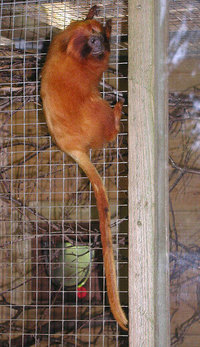Golden Lion Tamarin
|
|
| Golden Lion Tamarin Conservation status: Critical | ||||||||||||||
|---|---|---|---|---|---|---|---|---|---|---|---|---|---|---|
 | ||||||||||||||
| Scientific classification | ||||||||||||||
| ||||||||||||||
| Binomial name | ||||||||||||||
| Leontopithecus rosalia Linnaeus, 1766 |
Golden Lion Tamarins (Leontopithecus rosalia) are small New World monkeys of the family Cebidae. Native to the humid coastal forests of Brazil, Golden Lion Tamarins are an endangered species and among the rarest animals in the world, with an estimated wild population of 1,000 individuals; there are about 500 in captivity.
| Contents |
Description
As their name would suggest, these lion tamarins are a reddish orange to golden brown in colour. Their hair is longer and darker around the face, forming a mane on top of the head and on the cheeks and throat. Their limbs are slender yet capable with sharp claws, befitting their strictly arboreal lives. Although quite long, their tails are not prehensile. The tails and forepaws may have a black coloration. Golden Lion Tamarins may reach a maximum weight of just 650 grams. Their bodies may be up to 335 millimetres in length and their tails up to 400 mm. Males are somewhat larger than females.
Habitat
Most of the wild population is confined to the Reserva Biologica de Poço das Antas, a protected area of swampy forests in the state of Rio de Janeiro. It is an important bastion of the Golden Lion Tamarin, as only 2% of forests in the monkeys' original range remains. Furthermore, their existing habitat has been broken up by logging and agriculture; this has led to isolated populations and inbreeding, a combination likely to result in extinction.
A high canopy with dense tangles of vines is required by the Golden Lion Tamarin; other than providing a home, the labyrinthine forest affords some degree of protection from their many predators. Their main predators are raptors, large cats and snakes. The canopy also provides an important source of food; the omnivorous tamarins rely on rainwater and insects concentrated in the reservoirs of bromeliads and other small animals inhabiting the bark of trees. Fruit is also eaten.
Behaviour and reproduction
Golden Lion Tamarins are diurnal and primarily arboreal, forming small troops of up to nine individuals, led by a breeding pair; occasionally two unrelated males may be involved, but only one actually mates with the lead female. The troop patrols a consistent territory of c. 400,000 square metres; fighting between troops is avoided by scent marking and "ritual encounters". By night, the tamarins sleep in abandoned nesting holes in trees, or in large bromeliads.
The troop is cooperative in the rearing of young; however, only the dominant female usually breeds. The males are responsible for the bulk of rearing duties, with the mother nursing only. Resources are shared among the troop, as are predator surveillance duties. The young are well cared for; that is, until adolescence. Unlike other primates, the maturing females are often the first to leave the troop (known as disperal); their rate of survival is low, as less than one quarter successfully integrate into a new troop or establish themselves in an unoccupied territory.
Fully mature at 2-3 years, Golden Lion Tamarins are able to breed at 18 months of age. The breeding season is from September to March. Gestation lasts for 126-130 days, usually ending in twin births; there may be up to two litters annually. The young tamarins are weaned after just 90 days; less than half of infants survive their first year of life. If they do, a lifespan of 8-15 years can be expected. One captive tamarin has been reported to be 28 years old.
In an attempt to curb the Golden Lion Tamarin's precipitous decline, several conservation programmes have been undertaken. The intent is to strengthen the wild population and maintain a secure captive population in zoos worldwide. The survival rate of re-introduced animals has been encouraging, but desolation of their unprotected habitat continues.
External link
- Smithsonian National Zoological Park's Golden Lion Tamarin Conservation Program (http://nationalzoo.si.edu/ConservationAndScience/EndangeredSpecies/GLTProgram/Learn/BasicFacts.cfm)bg:Златист лъвски тамарин
